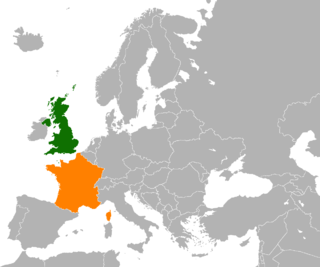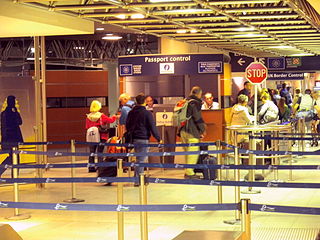
TransManche Link (Cross Channel Link) or TML was a British-French construction consortium responsible for building the Channel Tunnel under the English Channel between Cheriton in England, and Coquelles in France.

TransManche Link (Cross Channel Link) or TML was a British-French construction consortium responsible for building the Channel Tunnel under the English Channel between Cheriton in England, and Coquelles in France.
In April 1985 the British and French governments invited proposals for the construction of a link between the two countries to be privately funded. In January 1986 the two governments selected the Channel Tunnel Group/France Manche proposal for the construction of two undersea tunnels. At Canterbury Cathedral on 12 February 1986 the governments signed a treaty approving construction of the Channel Tunnel. In March the concession for the operation of the tunnel was given to Channel Tunnel Group (CTG) and France Manche (FM).
Following the award of this concession CTG was subsumed by the newly formed Eurotunnel plc and FM was similarly replaced with Eurotunnel SA, together these formed the Eurotunnel Group.
In July 1985 the British contractors formed Translink Contractors and the French consortium formed Transmanche Construction. On 18 October 1985 these two groups were merged to create TransManche Link (TML). TML was thus contracted to build the tunnel for its customer, Eurotunnel, who would own and operate it. TML senior management were employees of the partner companies seconded to the new organisation.
In October 1986 Eurotunnel was partially floated and the contractors and banks no longer exercised control over the company. Beginning in 1987 relations between TML and Eurotunnel deteriorated, with significant and increasingly public rows erupting over cost and programme management.
With the completion of the Channel Tunnel TML ceased to exist.

The participants were as follows: [1]
Channel Tunnel Group (later Translink Contractors)
France Manche (later Transmanche Construction)

The Channel Tunnel , also known as the Chunnel, is a 50.46-kilometre (31.35 mi) railway tunnel that connects Folkestone with Coquelles beneath the English Channel at the Strait of Dover. It is the only fixed link between the island of Great Britain and the European mainland. At its lowest point, it is 75 metres (250 ft) deep below the sea bed and 115 metres (380 ft) below sea level. At 37.9 kilometres (23.5 mi), it has the longest underwater section of any tunnel in the world, and is the third longest railway tunnel in the world. The speed limit for trains through the tunnel is 160 kilometres per hour (100 mph). The tunnel is owned and operated by the company Getlink, formerly "Groupe Eurotunnel".

High Speed 1 (HS1), legally the Channel Tunnel Rail Link (CTRL), is a 67-mile (108 km) high-speed railway linking London with the Channel Tunnel.

Getlink, formerly Groupe Eurotunnel, is a European public company based in Paris that manages and operates the infrastructure of the Channel Tunnel between England and France, operates the Eurotunnel Shuttle train service, and earns revenue on other trains that operate through the tunnel.

Roma Street railway station is located in the Brisbane central business district, Queensland, Australia. It is the junction station for the North Coast, Main, Gold Coast and NSW North Coast lines. The station is one of four inner city stations that form a core corridor through the centre of Brisbane.

Vinci is a French concessions and construction company founded in 1899 as Société Générale d'Enterprises. Its head office is in Nanterre, in the western suburbs of Paris. Vinci is listed on Euronext's Paris stock exchange and is a member of the Euro Stoxx 50 index.
TML may refer to:

The Eurotunnel Class 9 or Class 9000 are six-axle high-power Bo′Bo′Bo′ single-ended electric locomotives built by the Euroshuttle Locomotive Consortium (ESCL) of Brush Traction and ABB. The class was designed for and is used exclusively to haul the Le Shuttle road vehicle services through the Channel Tunnel.
Mott, Hay and Anderson (MHA) was a successful 20th century firm of consulting civil engineers based in the United Kingdom. The company traded until 1989, when it merged with Sir M MacDonald & Partners to form Mott MacDonald.

The Strait of Gibraltar crossing is a hypothetical bridge or tunnel spanning the Strait of Gibraltar that would connect Europe and Africa. The governments of Spain and Morocco appointed a joint committee to investigate the feasibility of linking the two continents in 1979, which resulted in the much broader Euromed Transport project.

Costain Group plc is a British construction and engineering company headquartered in Maidenhead, England. Founded in 1865, its history includes extensive housebuilding and mining activities, but it later focused on civil engineering and commercial construction projects. It was part of the British/French consortium which constructed the Channel Tunnel at the end of the 1980s, and has been involved in Private Finance Initiative projects.
SeaFrance was a ferry company based in France, wholly owned by the French railways, SNCF, which operated ferry services between Calais, France, and Dover, England.

The Bank of the Republic of Haiti is the central bank of Haiti. It was formed in 1979 from the National Bank of the Republic of Haiti, which had served as the country's bank of issue since 1910, itself succeeding the National Bank of Haiti.

The Treaty of Canterbury was signed by British Prime Minister Margaret Thatcher, British Foreign Secretary Sir Geoffrey Howe, French President François Mitterrand and French Minister of Foreign Affairs Roland Dumas on 12 February 1986. It is the original document providing for the undersea tunnel between both countries. The treaty is significant and unusual because it is a modern and recent modification to the national borders of the UK and France. Similar proposals had made in the past but were never realised.

MS Al Andalus Express is a freight ferry owned by Eurotunnel and operated by FRS Iberia/Maroc. She was built in 1987 by Chantiers du Nord et de la Mediterranee, Dunkirk for Societe Nationale des Chemin de Fer Francais (SNCF) as a multi-purpose passenger and roll-on roll-off ferry for lorries and railway vehicles. After the introduction of Eurotunnel there was no need for a train ferry, so SNCF was losing money running her. She was acquired by SNAT and Stena Sealink in 1989, which operated the Nord Pas-de-Calais until 31 December 1995. From 1 January 1996 SNAT operated as SeaFrance. The vessel was renamed SeaFrance Nord Pas-de-Calais. SeaFrance operated until November 2011, and was liquidated on 9 January 2012. Eurotunnel won the bid for the three of the former SeaFrance vessels the original name of the vessel was restored, dropping the SeaFrance prefix. MyFerryLink started running on 20 August 2012, although Nord Pas-de-Calais joined in November 2012 following a refit. Following MyFerryLink's cessation of operations, mostly cited due to financial issues, the ferry was used directly by Eurotunnel to carry hazmat cargoes that are not allowed on regular train services.

The Eurotunnel Calais Terminal is a railway terminal built for the transport of road-going vehicles on specially constructed trains through the Channel Tunnel. The terminal is one of two, with the Eurotunnel Folkestone Terminal located at Cheriton, near Folkestone.

Juxtaposed controls are a reciprocal arrangement between Belgium, France, the Netherlands and the United Kingdom whereby border controls on certain cross-Channel routes take place before boarding the train or ferry, rather than upon arrival after disembarkation. With the exception of the Eurotunnel Shuttle route, customs checks remain unaffected by juxtaposed immigration controls and continue to take place upon arrival after disembarkation. Belgium, France and the Netherlands are all member states of the European Union and part of the border-free Schengen Area. The United Kingdom, on the other hand, has never participated in the Schengen Area, even when it was a member state of the European Union. As a result, juxtaposed controls aim to increase the convenience and efficiency of border checks when travelling by train or ferry between the Schengen Area and the UK by removing the need for immigration checks on arrival and by streamlining checks on departure. At the same time, juxtaposed controls are intended to detect and prevent illegal immigration. In 2016, there were over 56,000 instances when people were refused entry to the UK at the juxtaposed controls.
Jacques Gounon, born 25 April 1953, is a French senior civil servant and business manager who currently serves as president of Getlink.

Pedal cycles in the Channel Tunnel are normally allowed to cross the Channel Tunnel fixed link between the United Kingdom and France only by using the Eurotunnel cycle service, on board a Le Shuttle train. That consists of a minibus and bicycle trailer for six bicycles.

André Bénard was a French industrialist who, as chairman of Eurotunnel, "helped lead the construction of the Channel Tunnel linking France and Britain. He retired as chairman of Eurotunnel Group after the 31-mile tunnel opened in 1994, but later was accused by investors of misleading them about prospects for the project. In 2007, a French court cleared him of those charges." He was married to Jacqueline Bénard, a former magazine editor.
Sir Joseph Anthony Dwyer was a British civil engineer and businessman. He joined Wimpey in 1955 and spent 44 years with the firm, becoming chief executive officer and chairman. Dwyer was responsible for repositioning Wimpey as a housebuilder by swapping its contracting arm for Tarmac's housing division. Wimpey subsequently saw a 30-fold increase in pre-tax profits. Dwyer served as chairman of the British part of TransManche Link, which built the Channel Tunnel and, after his 1999 retirement from Wimpey, served as president of the Institution of Civil Engineers. In the early 2000s he was chairman of the Liverpool Vision urban regeneration company and oversaw £2 billion of capital investment in regeneration projects including refurbishments of Lime Street station and King's Dock and construction of Liverpool Arena. Dwyer was appointed a deputy lieutenant of Merseyside in 2008 and a non-executive director of Cross London Rail Links in the same year.